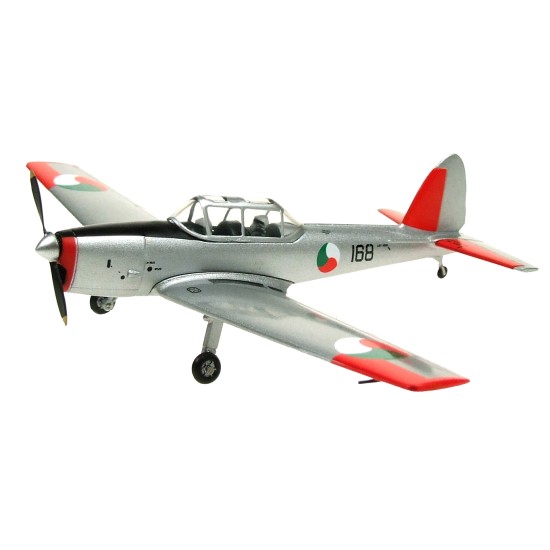
AV7226017 - 1/72 DHC1 CHIPMUNK IRISH AIR CORPS 168
Designed and developed immediately after World War II, by de Havilland Canada, as a trainer replacement for the de Havilland Tiger Moth biplane, the DHC-1 Chipmunk first took to the skies at DHC's Downsview base, near Toronto, on 22nd May 1946. Into service within months, the Chipmunk was procured in large numbers by the Royal Canadian Air Force (RCAF) and Royal Air Force (RAF). Now, nearly 80 years after the type first entered service, hundreds of Chipmunks remain airworthy and are in operation around the world.
A total of 1,283 Chipmunks were built - 217 by de Havilland Canada, until production ended in 1956, and 1,000 were built under licence by de Havilland itself - initially at Hatfield Aerodrome before production was transferred to Broughton, near Chester. A further 66 were manufactured by OGMA (Oficinas Gerais de Material Aeronautico), at Alverca in Portugal from 1955 to 1961, for the Portuguese Air Force. Amazingly, six are still in service with the Forca Aerea Portuguesa today.
The prototype was fitted with the air-cooled Gipsy Major 1C, but production aircraft in Canada (designated T.1 and T.2) were fitted with the Gipsy Major 8. Those produced in the UK (T.10) also had the Gipsy Major 8. The RAF took 735 T.10s, seeing action with the Royal Navy and Army too, and 217 were exported and redesignated as Mk 20s. The Mk 21 was the civilian production version - 28 were built.
Many Chipmunks that had been in military use were sold to civilians when they were struck off charge, either to private owners or to companies. Typically, these were used for a variety of purposes, often involving the type's excellent flying characteristics and its capability for aerobatic manoeuvres.
Towing gliders and crop spraying have been two areas where the Chippie's talents are still used today. Conversion to civil use saw the T.10 redesignated as Mk 22, with five converted for agricultural spraying duties as Mk 23.
The Irish Air Corps operated Chipmunks as part of its trainer fleet for many years and this is the first of (so far) two in these colours. It has also been released wearing its 2016 livery as AV7226021 with the registration 164.
A total of 1,283 Chipmunks were built - 217 by de Havilland Canada, until production ended in 1956, and 1,000 were built under licence by de Havilland itself - initially at Hatfield Aerodrome before production was transferred to Broughton, near Chester. A further 66 were manufactured by OGMA (Oficinas Gerais de Material Aeronautico), at Alverca in Portugal from 1955 to 1961, for the Portuguese Air Force. Amazingly, six are still in service with the Forca Aerea Portuguesa today.
The prototype was fitted with the air-cooled Gipsy Major 1C, but production aircraft in Canada (designated T.1 and T.2) were fitted with the Gipsy Major 8. Those produced in the UK (T.10) also had the Gipsy Major 8. The RAF took 735 T.10s, seeing action with the Royal Navy and Army too, and 217 were exported and redesignated as Mk 20s. The Mk 21 was the civilian production version - 28 were built.
Many Chipmunks that had been in military use were sold to civilians when they were struck off charge, either to private owners or to companies. Typically, these were used for a variety of purposes, often involving the type's excellent flying characteristics and its capability for aerobatic manoeuvres.
Towing gliders and crop spraying have been two areas where the Chippie's talents are still used today. Conversion to civil use saw the T.10 redesignated as Mk 22, with five converted for agricultural spraying duties as Mk 23.
The Irish Air Corps operated Chipmunks as part of its trainer fleet for many years and this is the first of (so far) two in these colours. It has also been released wearing its 2016 livery as AV7226021 with the registration 164.
£34.99
Ex Tax: £29.16
- Stock: In Stock
- Model: AV7226017
- Weight: 500.00g
- SKU: AV7226017

